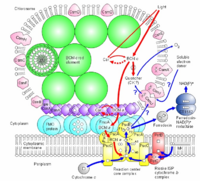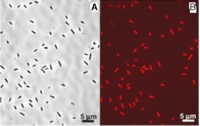Candidatus Chloracidobacterium thermophilum: Difference between revisions
| Line 17: | Line 17: | ||
[[Image:photo.png|thumbnail|200px|Figure 3. Model of the photosynthetic apparatus in ''Chlorobium tepidum'' [5]]] | [[Image:photo.png|thumbnail|200px|Figure 3. Model of the photosynthetic apparatus in ''Chlorobium tepidum'' [5]]] | ||
''Cab.thermophilum'' has light harvesting antennae (chlorosomes), where each chlorosomes contains 250,000 chlorophylls. ''Cab.thermophilum'' synthesizes bacteriochlorophylls a and c (BChl) under oxic conditions (photoheterotropically) unlike the anoxic conditions in other phototrops | ''Cab.thermophilum'' has light harvesting antennae (chlorosomes) and type 1 reaction centers, where each chlorosomes contains 250,000 chlorophylls. ''Cab.thermophilum'' synthesizes bacteriochlorophylls a and c (BChl) under oxic conditions (photoheterotropically) unlike the anoxic conditions in other phototrops. Characterization of a model green sulfur bacterium ''Chlorobium tepidum'' showed that BChl c molecule forms large aggregates by self-organization due to its unique molecular structure. The formation of large molecular aggregates of BChl c is independent of any protein scaffold. This protein-independent and self-organization properties leads to the formation of high amount of BChl c (eg. in Green sulfur bacteria, 25% of the total cellular carbon is utilized in the formation of BChl c and contains about 50 million BChl c molecules) needed for cell growth at very low light environment. Genome sequencing of a phototroph from the ''Chlorobi'' phylum, ''Chlorobium tepidum'' has shown the involvement of six genes in the formation of BChl c molecule and a photosynthetic apparatus model is proposed (Figure 3).[5,6] Due to lack of whole genome information of ''Cab.thermophilum'', it is not clear if the same photosynthetic mechanism is applicable to this bacterium but some similiarity may be expected. | ||
The biochemical analysis of ''Cab.thermophilum'' chlorosomes has shown the presence of ketocarotenoids, similiar to ''Cyanobacteria'', which may have the role in photo protection under the oxic conditions. Further ongoing characterization (biochemical and genome sequencing) at Pennsylvania State University, Montana State University, and Los Alamos National Laboratory will elucidate the role and diversity of this novel bacterium. | The biochemical analysis of ''Cab.thermophilum'' chlorosomes has shown the presence of ketocarotenoids, similiar to ''Cyanobacteria'', which may have the role in photo protection under the oxic conditions. Further ongoing characterization (biochemical and genome sequencing) at Pennsylvania State University, Montana State University, and Los Alamos National Laboratory will elucidate the role and diversity of this novel bacterium. | ||
Revision as of 22:31, 7 March 2008

Classification
Domain (Bacteria); Super Phylum (Fibrobacteres/Acidobacteria group); Phylum (Acidobacteria); Class (Acidobacteria); Order (Acidobacteriales); Family (Acidobacteriaceae); Genus (Chloracidobacterium)
Species
Candidatus Chloracidobacterium thermophilum
Description and Significance
A novel photosynthesizing bacterium named as Candidatus Chloracidobacterium thermophilum (Cab. thermophilum) has been recently (2007) discovered in Yellowstone’s hot springs by a collaborative research between Pennsylvania State University and Montana State University. The research was funded by National Science Foundation, Department of Energy, and the NASA Exobiology Program.[1]

The researchers have found the genetic evidence of this novel bacterium in three hot springs (Mushroom Spring, Octopus Spring, Green Finger Pool) in Yellowstone National Park (Figure 1A). It resides in the phototropic microbial mats at moderately high temperature (50-66 degree celsius) and in alkaline environment (pH 8.5) (Figure 1B).Based on phylogenetic analysis (16S rRNA), it is considered to be a member of the Acidobacteria phylum, which did not previously contain any phototrophs. In addition, the analysis showed that microorganisms closely related to Cab.thermophilum also exist in hot springs in Tibet and Thailand.[1] The importance of this discovery is reflected by 'This is only the third time in the last 100 years that a new group of phototrophs has been discovered'.[2]
Till date, chlorophyll based phototrophy is known to be present in only five groups or phyla of photosynthetic microorganisms (Cyanobacteria, Chloroflexi, Chlorobi, Proteobacteria and Firmicutes).[3] These phototropic microorganisms contain specific type of photosynthetic pigments (bacteriochlorophylls) to absorb specific wavelengths of light and differ in the type of molecular functions for the conversion of light into chemical energy (Figure 2). Different groups of phototropic microorganisms contain different types of bacteriochlorophylls.[4] For example Bacteriochlorophyll a-Purple bacteria, Cab.thermophilum :Bacteriochlorophyll b-Purple bacteria :Bacteriochlorophyll c-Green sulfur bacteria,Chloroflexi, Cab.thermophilum :Bacteriochlorophyll d-Green sulfur bacteria :Bacteriochlorophyll e-Green sulfur bacteria :Bacteriochlorophyll g-Heliobacteria
Cab.thermophilum has light harvesting antennae (chlorosomes) and type 1 reaction centers, where each chlorosomes contains 250,000 chlorophylls. Cab.thermophilum synthesizes bacteriochlorophylls a and c (BChl) under oxic conditions (photoheterotropically) unlike the anoxic conditions in other phototrops. Characterization of a model green sulfur bacterium Chlorobium tepidum showed that BChl c molecule forms large aggregates by self-organization due to its unique molecular structure. The formation of large molecular aggregates of BChl c is independent of any protein scaffold. This protein-independent and self-organization properties leads to the formation of high amount of BChl c (eg. in Green sulfur bacteria, 25% of the total cellular carbon is utilized in the formation of BChl c and contains about 50 million BChl c molecules) needed for cell growth at very low light environment. Genome sequencing of a phototroph from the Chlorobi phylum, Chlorobium tepidum has shown the involvement of six genes in the formation of BChl c molecule and a photosynthetic apparatus model is proposed (Figure 3).[5,6] Due to lack of whole genome information of Cab.thermophilum, it is not clear if the same photosynthetic mechanism is applicable to this bacterium but some similiarity may be expected.
The biochemical analysis of Cab.thermophilum chlorosomes has shown the presence of ketocarotenoids, similiar to Cyanobacteria, which may have the role in photo protection under the oxic conditions. Further ongoing characterization (biochemical and genome sequencing) at Pennsylvania State University, Montana State University, and Los Alamos National Laboratory will elucidate the role and diversity of this novel bacterium.
Genome Structure
Describe the size and content of the genome. How many chromosomes? Circular or linear? Other interesting features? What is known about its sequence?
COMING SOON!!!
Cell Structure, Metabolism and Life Cycle
Cab. thermophilum is a Gram-negative, aerobic, rod-shaped bacterium. It is 2.5 microns long and about 0.7 microns in diameter (Figure 4).
Ecology and Pathogenesis
Habitat; symbiosis; biogeochemical significance; contributions to environment.
If relevant, how does this organism cause disease? Human, animal, plant hosts? Virulence factors, as well as patient symptoms.
COMING SOON!!!
References
[1] Donald A. Bryant, Amaya M. Garcia Costas,Julia A. Maresca,Aline Gomez Maqueo Chew,Christian G. Klatt,Mary M. Bateson,Luke J. Tallon, Jessica Hostetler, William C. Nelson,John F. Heidelberg, David M. Ward. "Candidatus Chloracidobacterium thermophilum: An Aerobic Phototrophic Acidobacterium". " Science". 2007. Volume 317. p. 523 - 526 [2]
[2] http://www.bmb.psu.edu/faculty/bryant/lab/Project/Acido/index.html
[3] D. A. Bryant, N.-U. Frigaard. "Prokaryotic photosynthesis and phototrophy illuminated". "Trends Microbiology". 2006. Volume 14. p. 488-496 [3]
[4] http://en.wikipedia.org/wiki/Bacteriochlorophyll
[5] Frigaard, N.-U. and Bryant, D. A. "Seeing green bacteria in a new light: genomics-enabled studies of the photosynthetic apparatus in green sulfur bacteria and filamentous anoxygenic phototrophic bacteria". "Archives of Microbiology". 2004. Volume 182. p. 265-276 [4]
[6] Frigaard, N.-U., Voigt, G. D., and Bryant, D. A. "Chlorobium tepidum mutant lacking bacteriochlorophyll c made by inactivation of the bchK gene, encoding bacteriochlorophyll c synthase". "Journal of Bacteriology". 2002. Volume 184. p. 3368-3376 [5]
Author
Page authored by Ahmad Farhan and Anadumaka V. Chike, student of Prof. Jay Lennon at Michigan State University.


